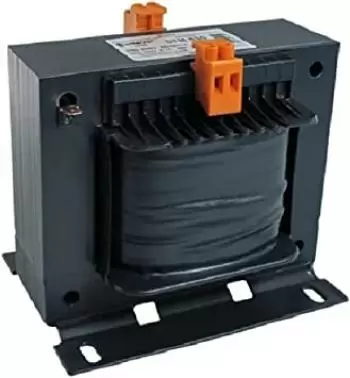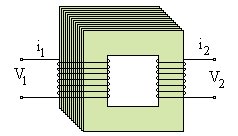
Single-phase alternating current is a method of transmitting alternating current using two wires. However, since the power transmission efficiency is low compared to three-phase AC, it is not used for high-voltage power transmission and distribution. Thus, it is used primarily to transmit low-voltage electric power (low-voltage power lines).
Not all electrical systems are designed to work with the same type of current, so it is sometimes necessary to transform the current. An electrical transformer is a machine that allows to modify some parameters of the electrical current such as the intensity and voltage of an electrical circuit without varying the power and frequency.
What is a single phase transformer?
A single-phase transformer is an electrical device for modifying the parameters of a single-phase alternating current. The current input and output is done with single-phase alternating current.
These types of electrical energy transformers allow the voltage to be reduced to a suitable value for use in other devices without varying the frequency. Physically it is made up of a magnetic iron core that acts as a magnetic component, and an electrical part made up of a copper winding.
Principle of operation of single-phase transformer
A single-phase transformer is made up of two coils of wire wound around an iron core. One of the two coils will be the primary coil which is also known as the inductor coil, the secondary coil is also known as the induced coil. So if it were a three-phase transformer, it would be made up of three coils.
 The working principle is based on Faraday's law. According to Faraday, the voltage that develops in a closed electrical circuit is according to the speed with which it transforms in time.
The working principle is based on Faraday's law. According to Faraday, the voltage that develops in a closed electrical circuit is according to the speed with which it transforms in time.
Electric current enters through the primary winding and induces an emf. The induced voltage becomes an alternating current when it passes through the magnetic circuit. Finally, passing through the alternating coils and diodes, they are converted back to direct current. The energy from one circuit passes to the other due to the magnetic field.
For example, if the input electrical voltage is 220 volts and the number of turns in the secondary coil is 200 times greater than that of the primary, its voltage will be 44,000 volts.
At the same time, since the relationship between power, current, and voltage is P=I*V according to the power formula, in an ideal transformer the electrical power in both coils would be the same.
The main advantage of this type of transformer is that the output voltage and current can be varied as desired.
Parts of a single phase transformer
The main parts of the construction of a single-phase transformer are:
-
The core of the transformer: typically, it is formed by ferromagnetic material whose objective is to maintain the electromagnetic flow.
-
Primary and secondary windings: it is the conductive wire that is normally copper that is wound in the core. The difference between transformers is based on the difference in turns between the primary and secondary windings.
-
Tap changer or tap changer: This is a usually mechanical device that can be altered to vary the output voltage levels of the transformer.
-
Ventilation system: this system dissipates the heat generated by the leakage flux and eddy current losses.
Characteristics of a single-phase transformer
The basic characteristics that all electrical transformer constructions have are:
-
The input and output frequency of the transformer is identical.
-
Its operation is based on Faraday's law and the laws of electromagnetic induction.
-
The primary and secondary coils do not have any electrical connection, and the magnetic flux carries out the energy transfer.
-
No moving parts are used, therefore no friction losses.
Uses and applications of single-phase transformers
The friction of electric current through high-voltage cables must be reduced to reduce heat losses during energy transport over long distances. This means that to compensate for the drop in resistance, the current must be increased according to Ohm's law.
However, this current must be transformed again for use in our homes. Power transformers are the devices that step down the voltage to the voltage we need.
Single-phase transformers are also used as voltage stabilizers of electrical appliances. The secondary winding is maintained when the nominal voltage is reached in a primary winding.
In industry, single-phase transformers are used in most processes formed by a magnetic field circuit that requires power to remain unchanged or to isolate a circuit.
Some examples of industrial uses are the following:
-
Production and manufacturing of electronic devices such as TV and radio.
-
Light generation in shopping centers and sports venues.
-
In urban areas, they are used to generate lighting with a lower voltage.
-
To control electrical systems.
-
To transmit and distribute electricity to other electrical systems.